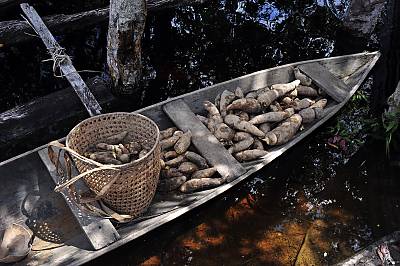- Brazil


Traditional Agricultural System of the Rio Negro in Brazil

1. ICH domains
Knowledge and practices concerning nature and the universe
2. Short description
The Rio Negro agricultural system is used in the upstream areas from the middle to the upper region of the Rio Negro tributary (São Gabriel da Cachoeira, Santa Isabel do Rio Negro and Barcelos municipalities, within the state of Amazonas) in Brazil. The system is used by more than 22 indigenous groups, including the Aruak (Baniwa, Kuripako, Baré, Werekena, Tariana) and the Eastern Tukano (Tukano, Desena, Kubeo, Wanana, Tuyuka, Pira-tapuya, Miriti-tapuya, Arapaso, Karapanã, Bará, Siriana, Makuna).
The Rio Negro traditional agricultural system is based on the cultivation of a tuberous root that is native to the Amazon region, commonly known as cassava or manioc (Manihot esculenta Crantz). Based on the knowledge of the local populations, the system consists of agricultural management practices of maniva and other cultivated plants, and techniques and artifacts for the processing of root tubers. Women play a vital role in the management of this agricultural system, from selecting the varieties of cassava to be cultivated to managing the fields and harvesting the crop.
The agricultural system comprises specific knowledge and practices, norms, social and historical relations, as well as oral tales and myths concerning nature and the universe, which supports caring for non-human beings.
Further information:
The National Institute of Historic and Artistic Heritage (IPHAN) of Brazil produced the following inventory report and video in Portuguese. The video shows the agricultural practice in the context of village life (both in Portuguese). The third resource looks at the ongoing transformations of this indigenous agricultural practice today (in English).
http://portal.iphan.gov.br/uploads/ckfinder/arquivos/Dossie_sistema_agricola_rio_negro.pdf
https://www.youtube.com/watch?v=ErYDzpNVzkY
https://www.researchgate.net/publication/260531309_Amerindian_Agriculture_in_an_Urbanising_Amazonia_Rio_Negro_Brazil
3. Link with sustainable development
This agricultural system promotes and supports a rich agricultural biodiversity, including a variety of crops, such as cassava, peppers, pineapples, yams and bananas. The system uses a slash-and-burn or shifting cultivation approach, a complex practice with a fallow period, which can improve soil fertility. In this way, the example of the Rio Negro agriculture system contributes to SDG 15 on the sustainable use and management of forests and terrestrial ecosystems. The transformation of the produce into different food products for use in village life also contributes to SDG 2 on achieving food security and promoting sustainable agriculture. In addition, this practice serves as a shared cultural reference among the different indigenous peoples.
4. Questions for reflection
What is the role of agricultural development institutions (schools, state or municipal agencies, agricultural finance institutions) in shaping the views of traditional agricultural knowledge vis a vis scientific-based practices based on modern technologies?
How is the growing interest in urban lifestyles among younger generations affecting traditional agricultural practices and ways of life?
In the face of such threats, how can communities sustain the viability and transmission of their agricultural knowledge systems and practices?